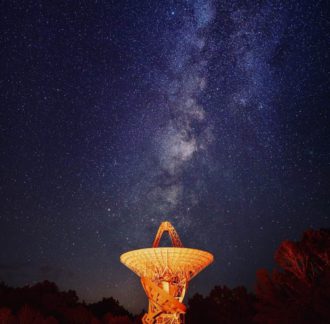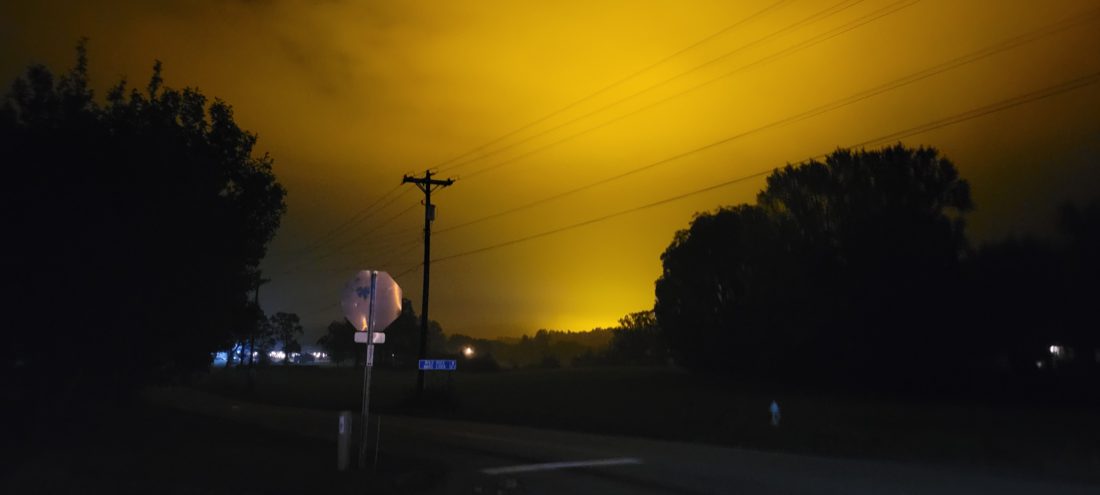When Lakeside Produce opened its 15-acre greenhouse in Mills River in July 2020, the facility’s owners and local leaders alike touted its environmental friendliness. The tomatoes grown there require roughly 15 times less water than those grown in traditional fields, and both water reuse and carbon capture systems are in place for more efficient operations.
Despite these measures, however, Lakeside Produce contributed to a different kind of greenhouse effect. On Oct. 1, the facility’s neighbors were disturbed when they saw its grow lights coloring the cloudy night sky a hazy orange-yellow.
“It was like an amber coral glow in the northern sky,” recalls Patricia Gearity, who saw the light from her home approximately 3 miles away. “I’ve never seen anything like that before.”
Driving home at 10 p.m., Mills River resident Susan Sauer stopped near the Mills River Brewing Co., about a mile away, to take a photograph. “It was horrible!” she says with a wry laugh.
The sight affected her so much that she drove by Lakeside Produce to investigate and noticed that a portion of the curtains used to reduce the brightness of the greenhouse was not in place. Sauer posted her pictures on the Nextdoor social network, asking, “Is this OK with you?”
For Gearity, Sauer and other residents who chimed in on Nextdoor from Horse Shoe, Haywood Knolls, Dogwood Forest and other neighborhoods, the situation was decidedly not OK. Mills River, they felt, had a light pollution problem.
Defined by the International Dark-Sky Association as “the inappropriate or excessive use of artificial light,” light pollution impacts more than 99% of the U.S. population. Beyond being an inconvenience for stargazers and a danger to nocturnal animals, too much of the wrong kind of light can cause night blindness and disrupt circadian rhythms. In 2016, the American Medical Association issued a statement advocating for lower-intensity LED streetlights based on those health impacts.
In recent years, many cities and counties nationwide have adopted outdoor lighting ordinances to limit the negative effects of light pollution. Neither Mills River nor Henderson County is among them, nor does either have plans to introduce any in the near future.
“I don’t want people to think we’re just turning all the lights off,” says Astronomy Club of Asheville advisory board member Bernard Arghiere, who worked closely on the outdoor lighting ordinances passed in Asheville and Buncombe County in 2012. “Outdoor lighting is much more than just protecting night skies. … The primary function is safety.”
Shades of green

With the notable exception of the IDA-certified dark sky park at the Pisgah Astronomical Research Institute in Transylvania County — one of only two such facilities in the state — few skies in Western North Carolina are untouched by light pollution. Most of the region scores around a 3 or 4 on the Bortle Scale, in which 1 is complete darkness and 9 is the Las Vegas Strip, the brightest spot on the planet. Central Asheville can get as high as a 6, while Mills River is usually a 4.
On a cloudy night when greenhouse lights are on, the sky above Mills River brightens significantly. Nevertheless, says Mark Williams, “Local growers have generally gone above and beyond what is legally required.” Williams is the executive director of Agribusiness Henderson County, a Hendersonville-based nonprofit dedicated to growing the agricultural sector.
He points out that Lakeside Produce planned to install curtains as the company developed the greenhouse; Van Wingerden International, also in Mills River, has used grow lights at night for 30 years without, to his knowledge, community pushback. “Free sunlight is preferred,” Williams says, but supplemental lighting is crucial during darker months and cloudy evenings to meet consumer demand, extend the growing season and make this form of agriculture economically viable.
“Greenhouse production includes light, and even with best efforts to reduce it, some still exists,” Williams says. “Benefits, on the other hand, are many – fresh, local, safe supply of food/plants; lower water and chemical usage; less transportation; jobs and tax revenues for county services.”
When asked specifically about the light issue in Mills River Oct. 1, Lakeside Produce spokesperson Jelena Dereta explained via email that a mechanical malfunction delayed the closing of the curtains when the lights came on around sunset. She said that Lakeside uses “industry leading” curtains that result in 90% light blockage.
Dereta emphasized that members of the company’s head office visit the area twice a week and would gladly sit down with residents to discuss any concerns over light pollution. “Being a good neighbor is extremely important to us,” she stressed.
“I don’t want to bash the greenhouses,” Sauer says, noting that she worked at the Van Wingerden facility when she first moved to the area in 2000. “I know you can’t take away all the light.”
Still, she says she misses the night sky that partly inspired her move to Mills River from Hendersonville. “My friends would come over, and we’d ‘ooh’ and ‘ahh’ on the stars and how amazing the night sky was here,” Sauer says. “It’s very few and far between that we get a really nice night sky here anymore.”
Less is more
In more urban areas such as Asheville, streetlights outshine greenhouses as a source of light pollution. While conventional wisdom suggests that more light leads to better nighttime vision, that’s not always the case. As Paul Bogard notes in his 2013 book The End of Night: Searching for Natural Darkness in an Age of Artificial Light, humans see best under focused light that shines directly onto an object, maximizing contrast with a dark background while minimizing light going directly into the eye.
One way to preserve this contrast is to install shielded lights known as cutoffs or full cutoffs. These designs focus beams downward, in contrast with the more common “cobra heads” that scatter light in all directions. Both Asheville and Buncombe County require most new outdoor lights to adhere to these standards, with the exemption of those in “historical” areas like Biltmore Village.
While the 2016 AMA statement on the health impact of outdoor lights briefly mentions shielding, it primarily focuses on correlated color temperature, or CCT. This metric, expressed using the Kelvin scale, indicates the temperature to which a black object would have to be heated to emit a certain type of light: The icily bright blue of some LED streetlights, for example, ranges from about 5,700 to 7,000 K, while the warm orange hues of sunset are roughly 1,850 K.
In 2012, when the Asheville and Buncombe County ordinances were enacted, 4,100 K was the lowest CCT readily available for streetlights. According to Arghiere, the city originally planned to set its upper CCT limit at 5,200 K until he intervened; the current limit for both the city and the county is 4,300 K. In 2016, however, the AMA recommended a CCT no higher than 3,000 K, pointing to studies showing correlations between exposure to high-CCT streetlights and poor sleep, obesity and even cancer. (Lighting industry bodies disputed the findings.)
“The No. 1 complaint from people in the city of Asheville is that those LED lights are extremely harsh. They’re glaring and they can cause night blindness,” Arghiere says.
Once the AMA statement came out, Arghiere presented the findings to the city’s Sustainability Advisory Committee on Energy and the Environment. In a subsequent memo from March 2017, the committee recommended that City Council adopt the lower CCT as the new threshold, but no formal action has been taken.
According to Amber Weaver, the city’s chief sustainability officer, the 3,000 K recommendation is part of ongoing discussions with Duke Energy about over 9,000 streetlights owned and operated by the city. “Over the last couple of years, the city has been working with the utility to address upgrading LED fixtures as well as lowering the Kelvin temperature,” she wrote in an email to Xpress.
Duke Energy has already installed some 3,000 K lights in WNC, replacing approximately 700 non-LED fixtures in Brevard in 2020. “They were pretty amenable to it,” recalls Jim Hardy, who participated in negotiations to get the lower CCT lights in 2018 as vice chair of the Pisgah Group of the Sierra Club.
While Hardy does not see the Brevard lights on a nightly basis from his home in Pisgah Forest, many residents have told him that they appreciate their warmer, yellower color. “I’ve had several people mention to me how much more friendly the lighting is in Brevard now,” he says.
Hardy also appreciates how shielded, lower-CCT LEDs can mitigate artificial light’s effects on humans and animals. Light pollution affects insects’ abilities to find food and reproduce, thereby contributing to mass declines of insect populations worldwide. Excess light also increases birds’ likelihood of colliding with buildings, especially during migration periods; one study conducted in Chicago estimates that halving nighttime lights could reduce bird deaths by as much as 60%.
Cities as varied as Los Angeles, Denver, Pittsburgh, Tucson, Ariz., Portland, Maine and Gloucester, Mass. have all instituted lower CCT lights. Arghiere feels it’s time for Asheville to do the same.
“This is not a maverick move,” he says.
Editor’s note: The credit for the second image featured in the story’s was updated on Dec. 6.






Before you comment
The comments section is here to provide a platform for civil dialogue on the issues we face together as a local community. Xpress is committed to offering this platform for all voices, but when the tone of the discussion gets nasty or strays off topic, we believe many people choose not to participate. Xpress editors are determined to moderate comments to ensure a constructive interchange is maintained. All comments judged not to be in keeping with the spirit of civil discourse will be removed and repeat violators will be banned. See here for our terms of service. Thank you for being part of this effort to promote respectful discussion.